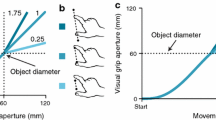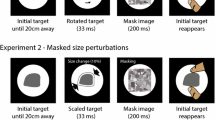Abstract
Normal subjects gradually preshape their hands during a grasping movement in order to conform the hand to the shape of a target object. The evolution of hand preshaping may depend on visual feedback about arm and hand position as well as on target shape and location at specific times during the movement. The present study manipulated object shape in order to produce differentiable patterns of finger placement along two orthogonal "dimensions" (flexion/extension and abduction/adduction), and manipulated the amount of available visual information during a grasp. Normal subjects were asked to reach to and grasp a set of objects presented in a randomized fashion at a fixed spatial location in three visual feedback conditions: Full Vision (both hand and target visible), Object Vision (only the object was visible but not the hand) and No Vision (vision of neither the hand nor the object during the movement). Flexion/extension angles of the metacarpophalangeal and proximal interphalangeal joints of the index, ring, middle and pinkie fingers as well as the abduction/adduction angles between the index-middle and middle-ring fingers were recorded. Kinematic analysis revealed that as visual feedback was reduced, movement duration increased and time to peak aperture of the hand decreased, in accord with previously reported studies. Analysis of the patterns of joint flexion/extension and abduction/adduction per object shape revealed that preshaping based on the abduction/adduction dimension occurred early during the reach for all visual feedback conditions (~45% of normalized movement time). This early preshaping across visual feedback conditions suggests the existence of mechanisms involved in the selection of basic hand configurations. Furthermore, while configuration changes in the flexion/extension dimension resulting in well-defined hand configurations occurred earlier during the movement in the Object Vision and No Vision conditions (45%), those in the Full Vision condition were observed only after 75% of the movement, as the moving hand entered the central region of the visual field. The data indicate that there are at least two control mechanisms at work during hand preshaping, an early predictive phase during which grip selection is attained regardless of availability of visual feedback and a late responsive phase during which subjects may use visual feedback to optimize their grasp.





Similar content being viewed by others
References
Berthier NE, Clifton RK, Gullapalli V, McCall DD, Robin DJ (1996) Visual information and object size in the control of reaching. J Motor Behav 28:187–197
Carlton LG (1981) Processing visual feedback information for movement control. J Exp Psychol Hum Percept Perform 7:1019–1030
Castiello U, Bonfiglioli C, Bennett M (1996) How perceived object dimension influences prehension. Neuroreport 7:825–829
Chieffi S, Gentilucci M (1993) Coordination between the transport and the grasp components during prehension movements. Exp Brain Res 94:471–477
Churchill A, Hopkins B, Ronnqvuist L, Vogt S (2000) Vision of the hand and environmental context in human prehension. Exp Brain Res 134:81–89
Connolly JD, Goodale MA (1999) The role of visual feedback of hand position in the control of manual prehension. Exp Brain Res 125:281–386
Desmurget M, Grafton S (2000) Forward modeling allows feedback control for fast reaching movements. Trends Cogn Sci 4:423–431
Galea MP, Castiello U, Dalwood N (2001) Thumb invariance during prehension movement: effects of object orientation. Neuroreport 12:2185–2187
Gardner E, Ro JY, Debowy D, Ghosh S (1999) Facilitation of neuronal activity in somatosensory and posterior parietal cortex during prehension. Exp Brain Res 127:329–354
Gentilucci M, Jeannerod M, Tadary B, Decety J (1994) Dissociating visual and kinesthetic coordinates during pointing movements. Exp Brain Res 102:359–366
Jackson SR, Jackson GM, Harrison J, Henderson L, Kennard C (1995) The internal control of action and Parkinson's disease: a kinematic analysis of visually-guided and memory-guided prehension movements. Exp Brain Res 105:147–162
Jakobson LS, Goodale MA (1993) Coordination between the transport and the grasp components during prehension movements. Exp Brain Res 86:199–208
Jeannerod M (1981) Intersegmental coordination during reaching at natural visual objects. In: Long J, Baddeley A (eds) Attention and performance XI. Erlbaum, Hillsdale, NJ
Jeannerod M (1984) The timing of a natural prehension movement. J Motor Behav 26:235–254
Jeannerod M (1997) The cognitive neuroscience of action. Blackwell, Cambridge, MA
Jeannerod M, Arbib M, Rizzolatti G, Sakata H (1995) Grasping objects: the cortical mechanisms of visuomotor transformation. Trends Neurosci 18:314–320
Kothari A, Poizner H, Figel T (1992) Interactive three-dimensional graphic analysis for studies of neural disorders of movement. SPIE Visual Data Interpretation 1668:82–92
Kuhtz-Buschbeck J, Stolze H, Johnk K, Boczek-Funcke A, Illert M (1998) Development of prehension movements in children: a kinematic study. Exp Brain Res 122:181–187
Luppino G, Murata A, Govoni P, Matelli P (1999) Largely segregated parietofrontal connections linking rostral intraparietal cortex (areas AIP and VIP) and the ventral premotor cortex (areas F5 and F4). Exp Brain Res 128:181–187
Mahalanobis PC (1936) On the generalised distance in statistics. Proc Indian Natl Inst Sci 2:49–55
Marzke M, Marzke R (2000) Evolution of the human hand: approaches to acquiring, analysing and interpreting the anatomical evidence. J Anat 197:121–140
Poizner H, Wooten E, Salot D (1986) Computerographic modeling and analysis: a portable system for tracking arm movements in three-dimensional space. Behav Res Methods Instr Comput 18:427–433
Poizner H, Mack L, Verfaellie M, Rothi LJG, Heilman KM (1990) Three-dimensional computerographic analysis of apraxia. Brain 113:85–101
Rizzolatti G, Camarda R, Fogassi L, Gentilucci M, Luppino G, Matelli P (1988) Functional organization of inferior area 6 in the macaque monkey. II Area F5 and the control of distal movements. Exp Brain Res 71:491–507
Santello M, Soechting JF (1998) Gradual molding of the hand to object contours. J Neurophysiol 79:1307–1320
Santello M, Flanders M, Soechting JF (2002) Patterns of hand motion during grasping and the influence of sensory guidance. J Neurosci 22:1426–1435
Schettino LF, Adamovich SV, Poizner H (2000) The role of visual feedback in the determination of hand configuration during grasping. Paper presented at the Society for Neuroscience 26th Meeting, New Orleans, LA
Shikata E, Tanaka Y, Nakamura H, Taira M, Sakata H (1996) Selectivity of the parietal visual neurones in 3D orientation of surface of stereoscopic stimuli. Neuroreport 7:2389–2394
Sivak B, Mackenzie CL (1992) The contributions of peripheral vision and central vision to prehension. In: Proteau L, Elliott D (eds) Vision and motor control. Elsevier Science, Amsterdam
Ungerleider L, Mishkin M (1982) Two cortical visual systems. In: Ingle DJ, Goodale MA, Mansfield RJW (eds) Analysis of visual behavior. MIT Press, Cambridge, pp 549–586
Wing A, Fraser C (1983) The contribution of the thumb to reaching movements. Q J Exp Psychol 35A:297–309
Wing A, Turton A, Fraser C (1986) Grasp size and accuracy of approach in reaching. J Motor Behav 18:245–260
Zeki S (1993) A vision of the brain. Blackwell, Oxford
Acknowledgements.
The research was supported in part by Research Grant 1 R01 NS36449-04 from the National Institute of Neurological Disorders and Stroke, National Institutes of Health, to Rutgers University. The authors would like to thank Drs. J. Soechting and M. Santello for providing them with the blueprints of the object shapes employed in this study.
Author information
Authors and Affiliations
Corresponding author
Rights and permissions
About this article
Cite this article
Schettino, L.F., Adamovich, S.V. & Poizner, H. Effects of object shape and visual feedback on hand configuration during grasping. Exp Brain Res 151, 158–166 (2003). https://doi.org/10.1007/s00221-003-1435-3
Received:
Accepted:
Published:
Issue Date:
DOI: https://doi.org/10.1007/s00221-003-1435-3




